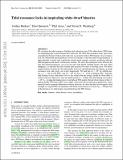Tidal resonance locks in inspiraling white dwarf binaries
Author(s)
Weinberg, Nevin N.; Burkart, Joshua; Quataert, Eliot; Arras, Phil
DownloadWeinberg_Tidal resonance.pdf (2.164Mb)
OPEN_ACCESS_POLICY
Open Access Policy
Creative Commons Attribution-Noncommercial-Share Alike
Terms of use
Metadata
Show full item recordAbstract
We calculate the tidal response of helium and carbon/oxygen (C/O) white dwarf (WD) binaries inspiraling due to gravitational wave emission. We show that resonance locks, previously considered in binaries with an early-type star, occur universally in WD binaries. In a resonance lock, the orbital and spin frequencies evolve in lockstep, so that the tidal forcing frequency is approximately constant and a particular normal mode remains resonant, producing efficient tidal dissipation and nearly synchronous rotation. We show that analogous locks between the spin and orbital frequencies can occur not only with global standing modes, but even when damping is so efficient that the resonant tidal response becomes a travelling wave. We derive simple analytic formulas for the tidal quality factor Q[subscript t] and tidal heating rate during a g-mode resonance lock, and verify our results numerically. We find that Q[subscript t] ∼ 10[superscript 7] for orbital periods ≲1–2 h in C/O WDs, and Q[subscript t] ∼ 10[superscript 9] for P[subscript orb] ≲ 3–10 h in helium WDs. Typically tidal heating occurs sufficiently close to the surface that the energy should be observable as surface emission. Moreover, near an orbital period of ∼10 min, the tidal heating rate reaches ∼10[superscript −2] L[subscript ⊙], rivalling the luminosities of our fiducial WD models. Recent observations of the 13-minute double-WD binary J0651 are roughly consistent with our theoretical predictions. Tides naturally tend to generate differential rotation; however, we show that the fossil magnetic field strength of a typical WD can maintain solid-body rotation down to at least P[subscript orb] ∼ 10 min even in the presence of a tidal torque concentrated near the WD surface.
Date issued
2013-05Department
Massachusetts Institute of Technology. Department of Physics; MIT Kavli Institute for Astrophysics and Space ResearchJournal
Monthly Notices of the Royal Astronomical Society
Publisher
Oxford University Press
Citation
Burkart, J., E. Quataert, P. Arras, and N. N. Weinberg. “Tidal resonance locks in inspiraling white dwarf binaries.” Monthly Notices of the Royal Astronomical Society 433, no. 1 (June 28, 2013): 332-352.
Version: Author's final manuscript
ISSN
0035-8711
1365-2966